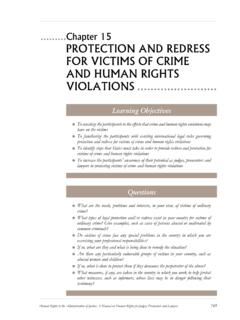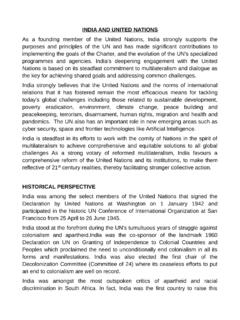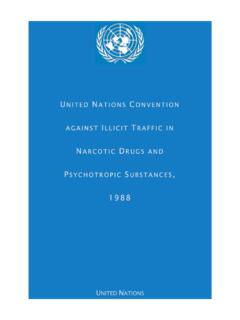Transcription of Council of Europe Convention on Action against Trafficking ...
1 The Agreement was previously published as Miscellaneous (2008) Cm 7465 Treaty Series No. 37 (2012) Council of Europe Convention on Action against Trafficking in Human Beings Warsaw, 16 May 2005 [The Convention entered into force in respect of the United Kingdom on 1 April 2009] Presented to Parliament by the Secretary of State for Foreign and Commonwealth Affairs by Command of Her Majesty July 2012 Cm 8414 Crown copyright 2012 You may re-use this information (not including logos) free of charge in any format or medium, under the terms of the Open Government Licence. To view this licence, visit or write to the Information Policy Team, The National Archives, Kew, London TW9 4DU, or e-mail: Any enquiries regarding this publication should be sent to us at Treaty Section, Foreign and Commonwealth Office, King Charles Street, London, SW1A 2AH This publication is also available on ISBN: 9780101841429 Printed in the UK by The Stationery Office Limited on behalf of the Controller of Her Majesty s Stationery Office ID 2501848 07/12 22198 19585 Printed on paper containing 30% recycled fibre content minimum.
2 3 Council OF Europe Convention ON Action against Trafficking IN HUMAN BEINGS Preamble The member States of the Council of Europe and the other Signatories hereto, Considering that the aim of the Council of Europe is to achieve a greater unity between its members; Considering that Trafficking in human beings constitutes a violation of human rights and an offence to the dignity and the integrity of the human being; Considering that Trafficking in human beings may result in slavery for victims; Considering that respect for victims rights, protection of victims and Action to combat Trafficking in human beings must be the paramount objectives; Considering that all actions or initiatives against Trafficking in human beings must be non-discriminatory, take gender equality into account as well as a child-rights approach; Recalling the declarations by the Ministers for Foreign Affairs of the Member States at the 112th (14-15 May 2003) and the 114th (12-13 May 2004) Sessions of the Committee of Ministers calling for reinforced Action by the Council of Europe on Trafficking in human beings; Bearing in mind the Convention for the Protection of Human Rights and Fundamental Freedoms (1950) and its protocols1; Bearing in mind the following recommendations of the Committee of Ministers to member states of the Council of Europe : Recommendation No.
3 R (91) 11 on sexual exploitation, pornography and prostitution of, and Trafficking in, children and young adults; Recommendation No. R (97) 13 concerning intimidation of witnesses and the rights of the defence; Recommendation No. R (2000) 11 on Action against Trafficking in human beings for the purpose of sexual exploitation and Recommendation Rec (2001) 16 on the protection of children against sexual exploitation; Recommendation Rec (2002) 5 on the protection of women against violence; Bearing in mind the following recommendations of the Parliamentary Assembly of the Council of Europe : Recommendation 1325 (1997) on traffic in women and forced prostitution in Council of Europe member states; Recommendation 1450 (2000) on violence against women in Europe ; Recommendation 1545 (2002) on a campaign against Trafficking in women; Recommendation 1610 (2003) on migration connected with Trafficking in women and prostitution.
4 Recommendation 1 Treaty Series No 71 (1953) Cmn 8969 4 1611 (2003) on Trafficking in organs in Europe ; Recommendation 1663 (2004) Domestic slavery: servitude, au pairs and mail-order brides; Bearing in mind the European Union Council Framework Decision of 19 July 2002 on combating Trafficking in human beings, the European Union Council Framework Decision of 15 March 2001 on the standing of victims in criminal proceedings and the European Union Council Directive of 29 April 2004 on the residence permit issued to third-country nationals who are victims of Trafficking in human beings or who have been the subject of an Action to facilitate illegal immigration, who cooperate with the competent authorities.
5 Taking due account of the United nations Convention against transnational organized Crime2 and the Protocol thereto to Prevent, Suppress and Punish Trafficking in Persons, Especially Women and Children3 with a view to improving the protection which they afford and developing the standards established by them; Taking due account of the other international legal instruments relevant in the field of Action against Trafficking in human beings; Taking into account the need to prepare a comprehensive international legal instrument focusing on the human rights of victims of Trafficking and setting up a specific monitoring mechanism, Have agreed as follows: Chapter I Purposes, scope, non-discrimination principle and definitions ARTICLE 1 Purposes of the Convention 1 The purposes of this Convention are: a to prevent and combat Trafficking in human beings, while guaranteeing gender equality; b to protect the human rights of the victims of Trafficking , design a comprehensive framework for the protection and assistance of victims and witnesses, while guaranteeing gender equality, as well as to ensure effective investigation and prosecution.
6 C to promote international cooperation on Action against Trafficking in human beings. 2 Treaty Series (2006) Cm 6852 3 Treaty Series (2006) Cm 6881 5 2 In order to ensure effective implementation of its provisions by the Parties, this Convention sets up a specific monitoring mechanism. ARTICLE 2 Scope This Convention shall apply to all forms of Trafficking in human beings, whether national or transnational , whether or not connected with organised crime . ARTICLE 3 Non-discrimination principle The implementation of the provisions of this Convention by Parties, in particular the enjoyment of measures to protect and promote the rights of victims, shall be secured without discrimination on any ground such as sex, race, colour, language, religion, political or other opinion, national or social origin, association with a national minority, property, birth or other status.
7 ARTICLE 4 Definitions For the purposes of this Convention : a " Trafficking in human beings" shall mean the recruitment, transportation, transfer, harbouring or receipt of persons, by means of the threat or use of force or other forms of coercion, of abduction, of fraud, of deception, of the abuse of power or of a position of vulnerability or of the giving or receiving of payments or benefits to achieve the consent of a person having control over another person, for the purpose of exploitation. Exploitation shall include, at a minimum, the exploitation of the prostitution of others or other forms of sexual exploitation, forced labour or services, slavery or practices similar to slavery, servitude or the removal of organs; b The consent of a victim of Trafficking in human beings to the intended exploitation set forth in subparagraph (a) of this article shall be irrelevant where any of the means set forth in subparagraph (a) have been used; c The recruitment, transportation, transfer, harbouring or receipt of a child for the purpose of exploitation shall be considered " Trafficking in 6 human beings" even if this does not involve any of the means set forth in subparagraph (a) of this article.
8 D "Child" shall mean any person under eighteen years of age; e Victim shall mean any natural person who is subject to Trafficking in human beings as defined in this article. Chapter II Prevention, co-operation and other measures ARTICLE 5 Prevention of Trafficking in human beings 1 Each Party shall take measures to establish or strengthen national co-ordination between the various bodies responsible for preventing and combating Trafficking in human beings. 2 Each Party shall establish and/or strengthen effective policies and programmes to prevent Trafficking in human beings, by such means as: research, information, awareness raising and education campaigns, social and economic initiatives and training programmes, in particular for persons vulnerable to Trafficking and for professionals concerned with Trafficking in human beings.
9 3 Each Party shall promote a Human Rights-based approach and shall use gender mainstreaming and a child-sensitive approach in the development, implementation and assessment of all the policies and programmes referred to in paragraph 2. 4 Each Party shall take appropriate measures, as may be necessary, to enable migration to take place legally, in particular through dissemination of accurate information by relevant offices, on the conditions enabling the legal entry in and stay on its territory. 5 Each Party shall take specific measures to reduce children s vulnerability to Trafficking , notably by creating a protective environment for them. 6 Measures established in accordance with this article shall involve, where appropriate, non-governmental organisations, other relevant organisations and other elements of civil society committed to the prevention of Trafficking in human beings and victim protection or assistance.
10 7 ARTICLE 6 Measures to discourage the demand To discourage the demand that fosters all forms of exploitation of persons, especially women and children, that leads to Trafficking , each Party shall adopt or strengthen legislative, administrative, educational, social, cultural or other measures including: a research on best practices, methods and strategies; b raising awareness of the responsibility and important role of media and civil society in identifying the demand as one of the root causes of Trafficking in human beings; c target information campaigns involving, as appropriate, inter alia, public authorities and policy makers; d preventive measures, including educational programmes for boys and girls during their schooling, which stress the unacceptable nature of discrimination based on sex, and its disastrous consequences, the importance of gender equality and the dignity and integrity of every human being.

















